Later Arabian geography scientists and travelers Ibn Khordadbeh (820/826-912/913), Abu-Ishaq Isterkhi (appr. 820-934), Azerbaijani scientist Mohamed Nakhchivani (late 13th-mid 14th centuries), Iranian scientists Reshidaddin Fazlullah (1247-1317) wrote about the economics of Azerbaijan, its administrative division, mountains and rivers, the distances between them, trade roads, etc.
Albanian (Caucasus) historian Musa Kalantarli (7-8th century) in his work "The History of Albania" described Albania as a world-famed country with a rich nature and dense population, fertile soils, beautiful gardens and green plains.
The world map (1459) of Venetian F.Maurov, the maps of Alsharif (1601), german scientist and traveler A. Olear), as well as the map "East Transcaucasia and the Caspian Sea", drawn in 1720 and issues in 1723 by order of Peter the First included the inhabited regions, lakes and rivers of Azerbaijan.
Azerbaijani geographical scientist Abdurrashid Bakuvi expressed his views on the climate of Azerbaijan, the nature of Baku and oil production in this town, Hadji Zeynalabdin Shirvani and Abbasqulu Aga Bakikhanov shared their opinions on the geographical features of our country. V.Abikh, I.Figurovsky, A.Zakharov and others made a great contribution to exploration of the territory of Azerbaijan as well.
Complex exploration of Azerbaijan started in period of the Soviet Union, when different scaled maps were issued and geographical atlases drawn.
The Academy of Science of Azerbaijan played an important role in comprehensive study of the territory of our country.

Historical and georgraphical position of the Azerbaijan Republic
Ancient Azerbaijan situated in Central Asia and covered the area from southeastern Caucasus till the mountain area south and south-east of the lake Urmia. Its area exceeds 200 thousand km2.
The entire Azerbaijan situates in northern hemisphere in approximately the same latitude with Spain, Greece, Turkey, China, Korea.
The strategically important roads leading from Europe to Central and Eastern Asia passed through Azerbaijan.
The territory of the republic extends 400 km from north to south, and 500 km from west to east, and locates between latitude 38`25"-41`55" North and longtitude 50`-50`51" East.
The Republic situating on the junction of Europe and Asia has a unique geopolitical and geographical position and had not lost its strategical importance for economic and cultural relations.
Landscape
Azerbaijan is characterized by a diversed landscape. There are two major forms of landscape-plains and mountains.
Mountains cover 60% of the total area of the Azerbaijan republic.
The principle geomorphological structures of Azerbaijan Republic -Major Caucasus, Minor Caucasus (with Garabagh plateau) and Talysh mountains surround the Kur-Araz lowland in the north, west and south-east.
The Nakhichevan Autonomous Republic is situated in the mid course of the River Araz and within the boundaries of Zengezur and Dereleyez chains of mountains, fringing with the river.
The average altitude of the territory of the Repiblic is up to 400 meters. But the lowland of the Caspian Sea shore is below sea level (currently -26.5 meters) while the highest peak Bazarduzu is 4466 meters in height. Thus, one can see that the difference in altitude equals nearly 4500 meters in the country. Northern part of Major Caucasus is situated in Azerbaijan. Two chins of mountains are distinguished in this part: Head or Watershed chain with Bazarduzu (4466 meters) and Great (Side) chain of mountains with Shahdag alp (4243). Mountains chains go down to 1000-700 meters to the South-East. The mountain chains of Major Caucasus are surrounded by foothill areas: a steppe plateau to the north-west, Qobustan to the south-east, Alazan-Ayrichay plain to the south-west and Qusar sloping plain to the north-east.

The mountains are formed by less exposed to denudation sinking rocks of Cretaceous and Jurassic periods.Foothills are characterized by badlands (Djeyranchol and Adjynour plains) and mud volcanos (Gobustan and Absheron). Qusar lpain and Alazan-Hefteran valley is composed of a thick layer of quaternary gravel sediments.
Minor Caucasus surrounds the country in the south-west and west and is composed of a number of chains and plateaus with relatively low height.
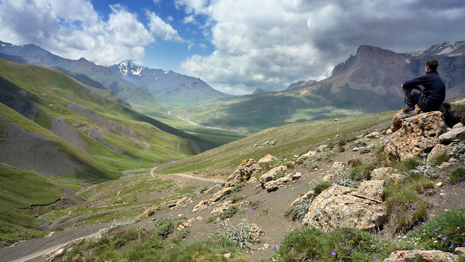
Murovdag, Shahdag and Zangezur are the principal chains of Minor Caucasus. Garabagh plateau, extending from the south of Murovdag up to the river Araz, lies on the cones of extinct vulcanos and quaternary lava.
Minor Caucasus is formed by Jurassic and Cretaceous volcanogene and sedimentary rocks.
Talysh mountains cover the south-east of the country. They are composed mainly of Tertiary sediments. Talysh mountains are the chain of transition from Minor Caucasus to Elbrus mountains in Iran. They consist of three mountain chains, reaching 2477 meters in height and a number of their ranges.
Kur-Araz lowland lies on the area between Major and Minor Caucasus and Talysh Mountains. As the largest intermontane lowland in the entire Transcaucasia it covers the central part of the country.
The Kur and Araz rivers divide the lowland into five plains: Shirvan, Qarabagh, Mil, Mughan and Salyan plains.
Samur-Devechi lowland, resting on Qusar sloping plain on the Caspian Sea shore, streches from Absheron peninsula to the north. Lenkeran lowland runs from the Absheron Peninsula to the south on the foothills of Talysh mountains. Kur-Araz, Samur-Devechi, Lenkeran lowlands and most part of the Absheron peninsula lie below sea level.
Climate
The climate in Azerbaijan is major influenced by geographical position, landscape and the Caspian Sea. The semidesert and dry, subtropic, temperate and frigid types of climate dominate in the country. It has been determined that Azerbaijan accounts for 8 out of 11 climate zones, existing in the world (by V.V.Keppen). Dry subtropical climate is typical for Kur-Araz lowland and Absheron.
Damp subtropic climate is observed only in Talysh mountains, foothills and Lenkeran lowlands. Temperate climate observed the slopes of Major and Minor Caucasus mainly covered with forests is divided into dry, warm-temperate dry, warm-temperate damp and temperate zones. Frigid climate is typical of high mountain ranges, at the tops of Major and Minor Caucasus, alpine, subalpine meadows.
The average annual temperatures equal 15 C on the plains while in high mountain regions they fall even below zero. Temperatures reach 25-27C in Aran regions and 5C in mountain regions in July. The absolute maximum is 43C, while the minimum is lower than -30C.
This minimal and maximal temperatures have been registered in Nakhichevan lowland and mountains.
Precipitation is also not equal across the territory of the country. The Absheron peninsula and Nakhichevan Autonomous Republic account for lower level of precipitation per year (200 meters). Precipitations equal 200-300 mm in Kur-Araz lowland, 600-800 mm on north-eastern slopes of Major and Minor Caucasus, 1200-1300 mm on southern slopes of Major Caucasus at a height of 2000-2500 meters. Precipitation is the highest (1200-1700 mm) in the south of Lenkeran lowland and foothills of Talysh mountains. Predominant winds blow to north (the Absheron peninsula), south-west (Kur-Araz lowland) and west (Lenkeran lowland).
İnland Water
The dense river system of the country covers its territory like a blue spider`s web. Azerbaijan accounts for 8400 small and large rivers, including 850 over 5 kilometers in length. Bust there are only 24 rivers extending to over 100 kilometers.
The rivers Kur and Araz-the largest rivers in the Caucasus, are the main sources of hydroelectric energy and irrigation.The river Kur originates at a height of 2740 meters on north-eastern slope of Qyzylgedikdagh in Turkey. It passes through Georgia and enters Azerbaijan, runs through Kur-Araz lowland and flow into the Caspian Sea. Its total length is 1515 km, with 906 kilometers in Azerbaijan. The area of its basin is 188 thousand kilometers. Mingechevir, Shamkir and Yenikend dams and hydroelectric power stations were constructed and big water reservoirs established on the river Kur. The reserves of two canals, carrying water from the Minchechevir reservoire, -Upper garabagh and Upper Shirvan canals-are used in irrigating the lands of Kur-Araz lowland.
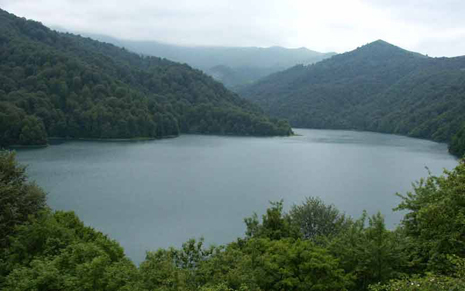
The River Araz originates from the Bingol mountains (2990) in Turkey and joins the Kur at Sabirabad (in Suqovushan village). It stretches to 1072 km and covers the area of 102 thousand km2.
The river Samur is the largest river in north-eastern Azerbaijan. It originates in Daghestan at a height of 3600 meters and flows into the Caspian Sea. It is 216 km in length and its area totals 4.4 thousand km2. Besides, the rivers Qusarchay, Qudyalchay, Velvelchay, Sumqayitchay, Vileshchay, Lenkeranchay and Astarachay flow in the Caspian Sea as well.
Azerbaijan has a great number of mountain rivers. Most rivers feed from snow and rains. The rivers Balakenchay, Talachay, Katehchay, Kurnurchay, Kishchay and other rivers, originating from Major Caucasus join the Alazan and Ayrichay rivers in Alazan-Ayrichay valley.
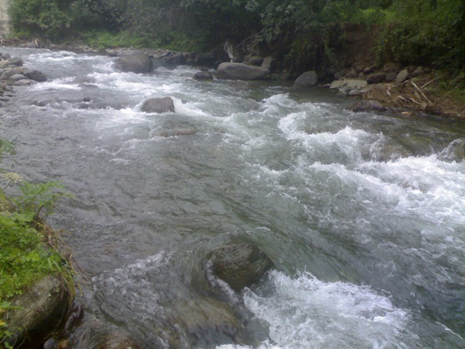
Rivers, running from Minor Caucasus as Agstafachay, Tovuzchay, Asrikchay, Zeyemchay, Shamkirchay, Ganjachay, Kurekchay, Terterchay flow into the Kur, while Hekerichay, Okhchuchay and Arpachay, Nakhichevanchay, Alianchay, Gilianchay and Ordubadchay of the Nakhichevan AR enter Araz.
Azerbaijan accounts for nearly 250 frech and salty lakes, differing by the sources of feeding and by origin. These include Tufangolu lake of glacial origin, the Goygol, Maralgol, Qaragol, Batanat, etc. formed by landslides, the Aggol, Sarysu, Mehman, Hadjyqabul, taking their origin from rivers and the largest salty lakes Adjinour, Boyukshor, Bineqedi, etc.
Vegetation
Azerbaijan has a rich flora. Almost all types of plants, found in the world are spread on the territory of this relatively small country. Nearly 4500 species of higher, spore-bearing flowering plants belong to 125 types and 920 genuses. Azerbaijan is richer than any other Caucasus countries by the total number of species. The republic accounts for 66% of all plant species found in the Caucasus. Along with plant species, widely spread in the Caucasus and other regions, Azerbaijan is also charactirezed by nearly 240 species of endemic plants. The vegetation spreads in accordance with physical and geographical formation of e region, modern cimate conditions, vertical zones and a number of other factors. Thus, plant species of desert and semi-desert and mire vegetation covers the plains to a height of 200 meters.
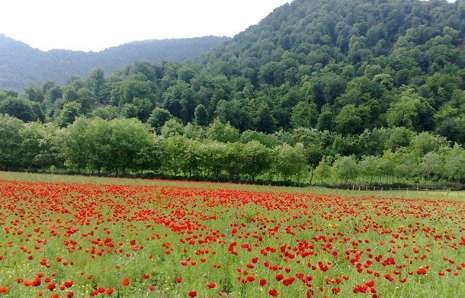
Desert type plants are found on the Caspian sea shore, south-eastern Shirvan, Mil, Mugan and Shirvan. Depending on the salinity of soils such plants as garasoran, shahsevdi gishotu, are widely spread in these regions.Semi-desert plants are widely-spread in Shirvan, Salyan, Mugan, Mil and Garabagh steppes, as well as in Djeyranchol, Qobustan plains and plains around the Araz. Absinth semi-deserts as zonal formations, dominate Kur-Araz, Qobustan and Djeyranchol plains. Among other formations garagan (Kur-Araz) and dengiz (Qobustan, Nakhichevan) are typical for Azerbaijan. Other widely spread plants of semi-deserts are bulbous bluegrass, Japanese brome, berk guramat, eatsern bozag, chilingburnu and a number of salinity herbs (cheren, shahsevdi, saltwort, gishotu. Tughai forests are peculiar of these areas. The forests covering the valleys of the Kur, Araz and Qabirri rivers contain such trees as oak, willow, birch-tree, ash-tree, etc.
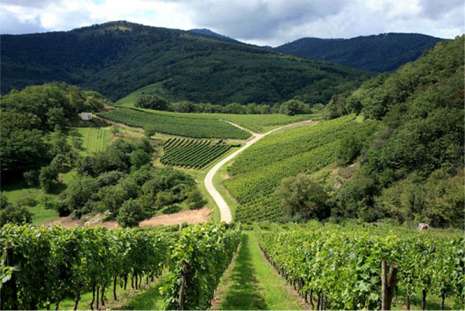
Foothill plains of Major and Minor Caucasus are mainly covered with annual and perennial xerophytic plants and bushes at a height from 200 meters up to 600-700 and sometimes even 1200 meters. The area above (up to 1800-2000 meters) is covered with forests.
Azerbaijan has an area of 86.6 million hectares, with 1213.7 thousand hectares of woodlands.
Thus forests account for 989.5 thousand hectares or 11.4% of the total area of the country. Per capita area of forests equals 0.12 hectares of land that is by 4 lower from the average global indicator (0.48 hectares).
Though Azerbaijan`s forests occupy relatively small area they are rich in species of trees. There are 435 tree and bush species with 70 species of endemic ones. The country is characterized by broad-leaved forests. Such forests are widely-spread on Major and Minor Caucasus and Talysh mountains. At a height of 600-1600 meters above sea level they form a single zone. In other areas they are preserved in glades and narrow strips.
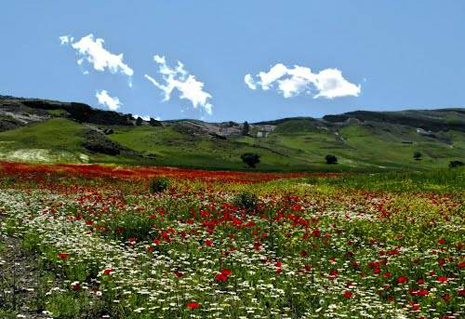
The forests are formed by three main types of trees-beech-tree, hornbeam and oak. They make up 86.2% of woodlands. Besides, forests also contain such broad-leaved trees as maple, elm, lime-tree, alder-tree, poplar, yalanyarpag, willow, etc. Needle-leaved forests account for 1.7% of the total area of forests. 7 species of needle-leaved trees out of 107 species of trees are naturally grown in the country. These are garajokesi, Eldar pine-tree, hookes pine, polycarpous, red and uzungovdeli juniper trees.
Azerbaijan is home to a number of rare trees and bushes. Garajoke is a rare relict tree of the Pertiary period. It is widely spread in south (Qabala) and south-east (Pirqulu and Shamakhy regions)of Major Caucasus. Though slow-growing yet long-lived garachohre does never cover large areas. Eldar valley of Djeyranchol foothill is home to Eldar pane-tree. Among relict and rare trees of Tertiary period iron-tree, Lenkeran acacia, chestnut-leaved oak, zelkova, Caucasus date palm, box-tree, wing nut, Hirkan fig-tree, Hirkan birch-tree, etc are rare patters of nature.
Fauna
Azerbaijan situates on the junction of a number of zzogeographical zones, characterized by a specific fauna. The animals from Iran, Central Asia amd Mediterranean Sea have been adppted to Azerbaijan thus enriching its nature. Due to the diverse natural conditions Azerbaijan formed a colorful animal kingdom. There are 97 species of mammals, 357 species of birds, 67 species of reptiles and Amphibians, 1 species of cyclostomes, 97 species of fish, over 15 thousand species of invertebrates on the territory of Azerbaijan.
The fauna of plains is represented by a great number of mammals, reptiles, amphibians and numerous sedentary and migrant birds.
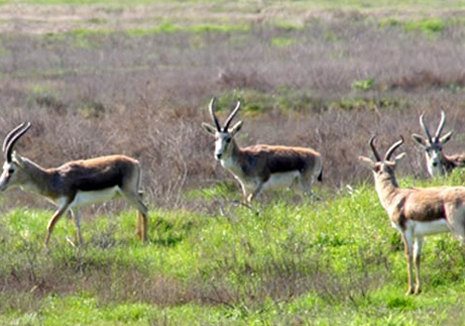
One can come across such mammals as djeyran gazelle, wild boar, wolf, fox, badger, cane cat, rabbit, etc, reptiles as swamp, Caspian and Mediterranean tortoise, striped lizard, ordinary and water grass-snake, adder, etc, amphibians-different species of tortoises, ansects, birds-pheasant, partridge, turaj, different kinds of ducks and geese, loud and hissing water birds, coot, eagle, gallinule, heron, cormorant, pelicane, etc. Beside animals found in plains and mountains, this areas are also characterized by such animal species as East Caucasus billy-goat, Caucasus roe deer, Caucasus chamois, Caucasus tetra, Caucasus donkey,etc.
The Red Book of the Azerbaijan Republic comprises 108 animal species, including 14 species of mammals, 36 species of birds, 13 species of reptiles and amphibians, 5 species of fich and 40 species of incests.
The minerals of Azerbaijan
The country is rich in three types of mineral products that are metallic, non-metallic and combustible mineral products. Azerbaijan is famous for its oil and gas deposits. 2/3 of the republic is rich in oil and gas. The Absheron Peninsula, Caspian shelf, Baku and Absheron archipelagoes account for the most part of deposits. Southeastern Shirvan, Central Aran, Qobustan, Djeyranchol, Adjinour and Siyezen are rich in oil.
The world-famed oil of Naftalan cures a number of diseases.
Gas deposits are found in Qatadagh, Caspian shelf, Baku and Absheron archipelago. The region of Minor Caucasus accounts for most part of metallic minerals: iron, manganese, titanium, chromium, copper, cobalt, complex ore, antimony, gold, silver, molybdenum, etc. The biggest deposit of iron was found in Dashkesen.
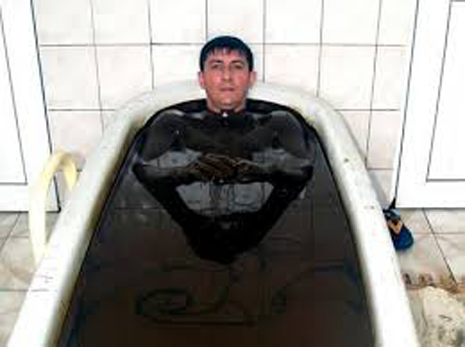
Among non-metallic minerals limestones of Qobustan, Absheron, Tovuz, travetin stones of Kelbadjar and Shahtakhty (Nakhichevan AR), marble of Dashkesan, gypsum of Upper Aghdjakend, alums of Hadjyveli and of great industrial importance.
The country is also rich in mineral waters, with different chemical ingredients. Due to that Azerbaijan is called the museum of mineral waters. Istisu (in Kelbedjar), Badamly and Sirab (in Nakhichevan AR) are famed mineral waters.
Surakhany andShykh of Absheron peninsula, Qalaalty, of Devechi district, Turshsu of Djulfa district are used as a treatment of a number of deseases.
Thermal waters dominate the Talysh mountains and southern and northeastern slopes of Major Caucasus.
The Caspian Sea
The Caspian Sea, largest enclosed water basin in the world is of great importance for Azerbaijani people. It has a unique physical and geographical properties, It should be noted that the flora and fauna of the Caspian Sea are rich in endemic species. For example, 90% of the total reserves of sturgeon, differing from other fishes by its antiquity, are found in this sea.
The specific geographical landscape created favorable recreational conditions. The sea stretches along a meridian in shape of latin letter "S" and it locates between latitude 47`17" north and longtitude 36`33"east.
The sea across the meridian stretches to nearly 1200 km, its average breadth is 310 the maximal and minimal breadth id 435 and 195 accordingly. As the level of the Caspian Sea changes periodically, the volume of water and its boundaries are also changeable. At present the level of the sea is 26.75 meters below sea level. At this level the area of the sea is 392600 km2 , the volume of water is 78648 km3. This volume makes up 44% of the total water reserves of all lakes in the world. Its maximum depth is 1025 meters and due to that the sea rivals the Black Sea, Baltic Sea and Yellow Sea and it is even deeper that the Adriatic Sea, Aegean Sea, Tiren Sea and Sulu Sea.
Caspian Azeri Sector occupies central and southern parts of the Sea. Caspian Sea water differs from that of the world ocean by its salinity. The salinity totals 5-6 ppm in the north and 12.6-13.5 ppm in south. 170 out of 300 mud volcanoes in Azerbaijan are located in the Caspian Azeri sector. The number of volcanoes is higher in the South Caspian Sea.
The uniqueness and colorness of natural conditions promoted the preservation of a number of rare flora and fauna species in the Caspian Sea up to present days.
The Caspian Azeri sector accounts for 171 species of phytoplankton, 40 species of animal plankton, 258 species of fitdentos, 91 species of macrozoodentos and 80 species and subspecies of fish belonging to 14 families. Carp-like fishes are the most numerous species-42 species, they are followed by gudgeons-31, herring-17, salmon fishes-2, sturgeon-5 species. The fish fauna of the Caspian Sea comprises 4 genuses, 31 species and 45 subspecies of endemic fiches. Most endemic fishes are registered in central part of the Caspian Sea.
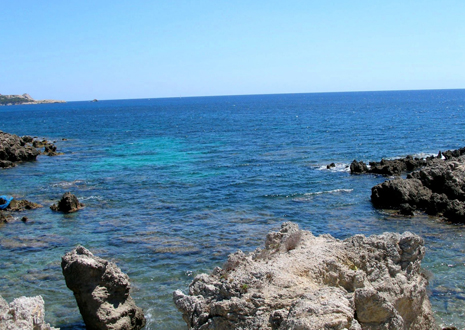
Approximately 40 species and subspecies of fish play important role in fishing. Flock accouns for the biggest part of the total fish fauna (80%) the remainder part comprises herring, grey mullet, friar, argentine, and gudgeon.
The Red Book of the Azerbaijan Republic includes the following species of rare and endangered species: stone-eel, sig, Southern Caspian white-eye, chekhon, sea pike-perch. In the last few years, the number of all kinds of sturgeon (beluga, spine, long-nosed sturgeon), Caspian salmon, white salmon, khramulya, shamai fish, shibrit, garasol, is decreasing rapidly and these fishes are on the verge of extinction. The seal is the only mammal found in the Caspian Sea . It is the smallest kind of all existing seals. The number of Caspian seals decreased from 1.5 million in early 20th century down to 360-400 thousand in 1980th. The Caspian seal was included into the Red Book in 1993.
302 species of birds have been registered on the Caspian Sea and its coastal regions: these include 37 species of water birds, 109 species of birds populating areas around water basins and 156 terraneous birds.
More about:








.jpg)







































